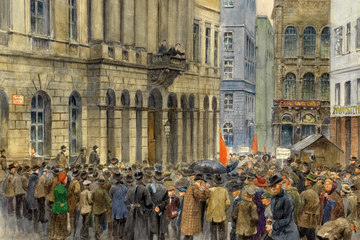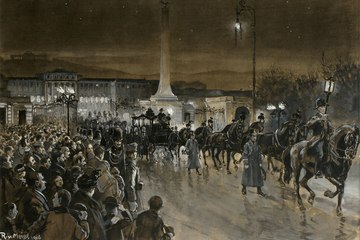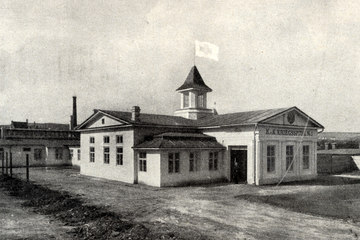Peter Eigner
Overthrow of the old values: post-war Vienna
The old world was increasingly falling apart. The collapse of the Habsburg Monarchy and the proclamation of the republic marked a clear change, but wartime and post-war Vienna showed remarkable parallels. An improvement in the living conditions of the people of Vienna was not in sight. Added to this was the fear or hope, depending on ideology, of revolution and a soviet dictatorship. From the end of October 1918 to June 1919 Vienna was the scene of bloody demonstrations and clashes.
Self-help: unofficial allotments and deforesting the Vienna Woods
Construction work came to a complete standstill when war broke out. In spite of the calamitous housing situation, it was not so much the housing shortage as the acute food shortages that led to the spread of allotments. The spontaneous activities that arose during the war were aimed above all at producing food.
Goodbye to the world of yesterday
As the war progressed, the indications that a decisive change was taking place became increasingly obvious. The initial euphoric patriotism and enthusiasm gave way to disillusionment and often bitterness. The year 1916 was the decisive turning point in the perception of the war due to the increasing shortages and the unpromising news from the front. Emperor Franz Joseph I, the most important representative of the ‘world of yesterday’, also died that year.
Vienna as a centre of the war economy
With the outbreak of the war, the economy had to be adapted to the new situation, and it contained several planned economy elements and dictatorial characteristics. This process was combined with the militarization of businesses and working conditions. A shortage of labour soon became apparent, compensated increasingly through the use of women. The lack of preparation for a war of this length and intensity can be seen as well in the dire supply situation to the population of Vienna, with shortages practically across the board.
Vienna as a refugee camp
The war became increasingly present in Vienna. Shortly after it started, thousands of refugees, including many Jews, began to stream into the city. Neither the city council nor the government was adequately prepared for this situation. And within the population, envy, aggression and increased anti-Semitism soon became evident.
Rebuilding for war: barracks and hospitals in Vienna
The outbreak of war put the dynamic urban development and construction in Vienna on hold. Building activity was dictated by the war, its unhappy progress and the inadequate preparation and organization. The constant flow of refugees and wounded soldiers made it necessary to transform Vienna into a city of barracks and hospitals.
The war takes over the city
Vienna was not a theatre of war, nor did it suffer destruction as a result of the fighting. Externally it changed very little, but the war quite clearly left its mark. War propaganda and patriotic enthusiasm dominated daily life in the city. The euphoria waned markedly as the war progressed and the supply situation became increasingly critical.
The growing city: Vienna on the eve of the First World Wa
By 1910 Vienna had grown to become an international metropolis with around 2.1 million inhabitants and worldwide cultural and scientific significance.









